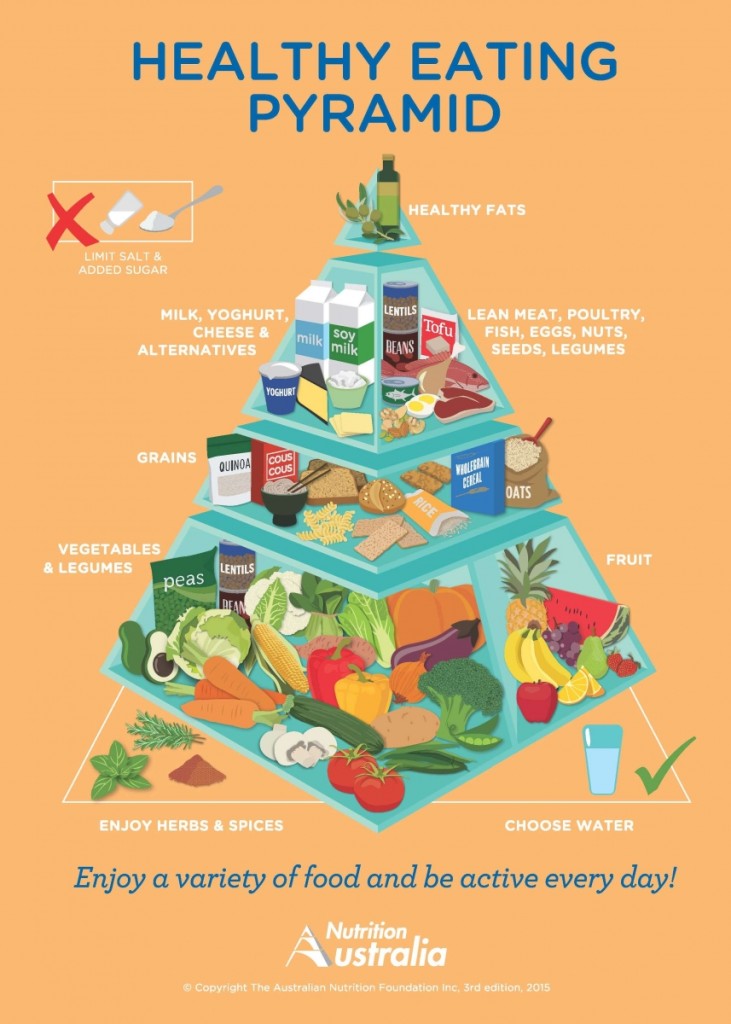What’s changed with Australia’s new food pyramid?
Making sense of what exactly is good and bad nutrition is a tough gig for most people. You could bet your bottom dollar that for every piece of information you find on what you should do, there will be a counter argument somewhere as to why you shouldn’t do it. Thankfully, Nutrition Australia finally released it’s new and revised food pyramid last month which aims to clear things up. Let’s take a closer look:
1. Vegetables take centre stage
The bottom layer of the food pyramid is now predominantly vegetables as well as legumes and fruit. With the high amounts of vitamins and minerals present in these foods, they have been linked to a reduced risk of a number of serious diseases such as cancer, heart disease, and type 2 diabetes.. Vegetables and fruit are also high in fibre which helps with weight control. Given an estimated (and shocking) 7% of Australians reach the recommended daily intake of vegetables, this is a good start to the new pyramid.
On a side note, while both are good options, still aim to eat more vegetables than fruit.
2. Include healthy grains
The renamed carbohydrates group has shifted up from the bottom of the pyramid to put more emphasis on Australians eating more vegetables. Carbohydrates, even with their bad reputation these days, are essential in a healthy diet and the new pyramid encourages (whole)grains such as quinoa, brown rice, multigrain breads, and oats which are also all rich in fibre. That being said, other carbohydrate options such as white rice are not poor options and can easily be included in a well balanced diet.
3. Have a mix of different sources of protein
The second top layer emphasises consuming a variety of protein sources from dairy, meat, and non meat products. While red and white meats are the obvious choices of protein, people often forget dairy products (such as cottage cheese and greek yoghurt; whey protein powder also falls in this category) are also rich in protein as well as being high in calcium.
Consuming a mixture of fish, nuts, and seeds will not only give you variety in your protein, but will also help you reach your recommended intake of healthy fats.
4. Fat is good
Fats are often neglected but they have major roles in the body which include manufacturing and balancing hormones and improving brain and nervous system health. A mix of monounsaturated and polyunsaturated fats are ideal for optimal health. They can be found in oils, avocados, nuts and seeds, fish, and eggs.
5. Junk food has been canned
The previous food pyramids had junk food at the top in the ‘eat in small amounts’ category, and whilst I think the amended food pyramid is much better, I will say that eating a small percentage (under 10% of your daily intake) on whatever you wish will not have an effect on your overall body composition and will also help you control cravings. For the average person though, not having the junk food option on the pyramid is the correct stance.
All in all, Nutrition Australia has done well with the updated version of the food pyramid. For the average person, it is a good starting point to refer to and if followed consistently would definitely improve the current eating habits of Australians unfamiliar with good nutrition practices. Putting more emphasis on vegetable intake is a much needed addition to the pyramid, and is definitely one aspect of nutrition which is hard to disagree on, regardless of what your good and bad nutrition stance is.

